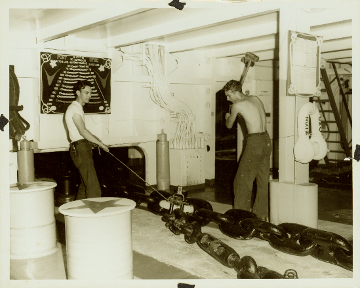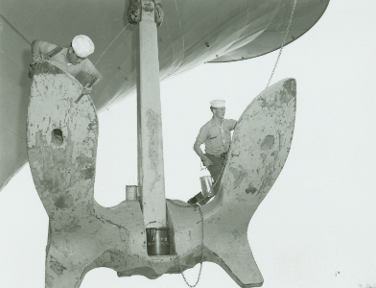510. Anchor Chain Room
On this page:
Location: FLIGHT Deck

Fast Facts
Sailors used the equipment in the anchor chain room to raise and lower Intrepid’s anchors. Windlasses heaved up the anchors, and stoppers held the chains to the deck.

Exhibit Description
Intrepid had two massive anchors at the bow of the ship. Each one weighed 30,000 pounds (13.6 metric tons), about the equivalent of ten automobiles. The anchors were raised and lowered on huge chains, and this is where the chains entered the ship. There are two anchor chains lying on the floor down the center of the room. They lie roughly parallel to each other and stretch from the bow end of the ship into the room. You can see about 50 feet (15.2 meters) of chain on the deck for each anchor. The shorter chain is about 900 feet (274.3 meters) long. Short lengths of chain called stoppers hold the anchor chains to the deck.
We invite you to crouch or kneel down to touch the massive anchor chains. The tops of the chains are about a foot (30 cm) off the floor. The chains are painted shiny black. To get a sense of their weight and design, find and feel one link in a chain. Each link is about two feet long and an oval shape, just like the shape of links on a necklace or chain you might wear around your neck. But unlike the links on your necklace, these links each weigh about 125 pounds!
Sailors used the equipment in this space to raise and lower Intrepid’s anchors. A machine called an anchor windlass controls the heavy chains. Some parts of the system are in this room, while other parts are belowdecks and not visible to visitors. In this room, each anchor chain winds around a large, flat cylinder called a wildcat. The wildcat has teeth around the edges to engage the chain links. One nearby wheel controls the speed, while another is the brake. The motor for the system is two decks below in the windlass room, and the rest of the chain winds down into the chain locker, six levels below where you are standing.
Anchoring did not happen often. In many ports, Intrepid could tie up to a pier. Today, huge mooring lines keep Intrepid from drifting down the Hudson River. You can see these some of these mooring lines here in the anchor chain room. In two places, you’ll find the lines wound around cylinders called bitts. The bitts are about as tall as your waist. Nearby is a large spool of rope about 5 feet (1.5 meters) tall.
Intrepid’s anchors are still attached to the ship. They are in their up position, against the bow of the ship. When you leave the Museum, you can see them when you look at the front of the ship.
Photos & Videos
Video description: Tour Guide Ronald Guggenheim explains the anchor chain room on board Intrepid. The large room has white walls, and the deck (floor) is black and gray. Lying across the deck are two massive lengths of black chain. Historical photographs show Intrepid’s anchor and sailors working in the anchor chain room.


More information
Today, Intrepid’s fo’c’sle is enclosed. However, when Intrepid was built, the forward part of the fo’c’sle, including the anchor chain room, was open to the wind and sea. In rough weather, seawater engulfed this part of the ship. During World War II, other aircraft carriers sustained significant damage when storms ripped through the fo’c’sle, collapsing the flight deck above.
On one occasion during World War II, Intrepid’s crew members took advantage of the open fo’c’sle to help their damaged ship return home. On February 16, 1944, Intrepid was part of a task force that attacked the Japanese naval base on Truk Atoll in Micronesia. Just after midnight on February 17, a Japanese torpedo tore through the stern of the ship, jamming the rudder. Eleven men perished, and 17 were wounded.
Intrepid lost all steering control. As the ship’s commanding officer, Capt. Thomas Sprague, observed after the fact, “She was like a giant pendulum, swinging back and forth. She had a tendency to weathercock into the wind… turned her bow toward Tokyo. But right then I wasn’t interested in going that direction.” Crew members tried to regain a steady course by varying propeller speeds. Still, they struggled to maneuver the wounded ship.
Enterprising crew members had an idea. They stretched a hastily-made canvas sail across the port (left) side of the anchor chain room. They also moved all of the ship’s airplanes to the forward part of the flight deck. This created wind resistance, helping Intrepid stay on course.
Intrepid limped to Pearl Harbor and then San Francisco for repairs. Four months later, Intrepid headed back to combat. During a refit in 1956–1957, Intrepid, like other aircraft carriers of its class, was fitted with a hurricane bow. The forward of the ship was enclosed all the way up to the flight deck.
Statistics
| Weight of each anchor: | 30,000 pounds |
| Weight of each chain link: | 125 pounds |
| Length of anchor chain: | c. 1,000 feet |